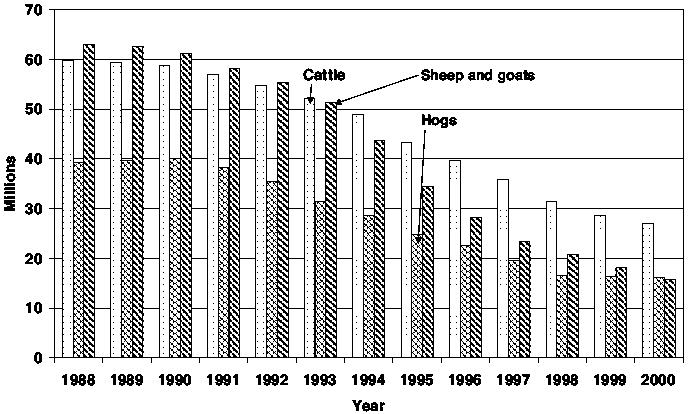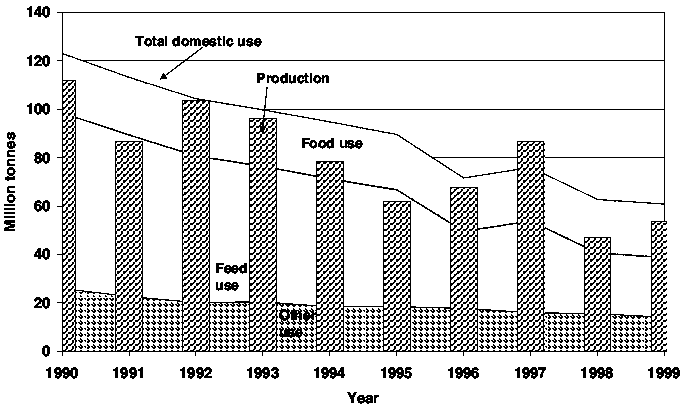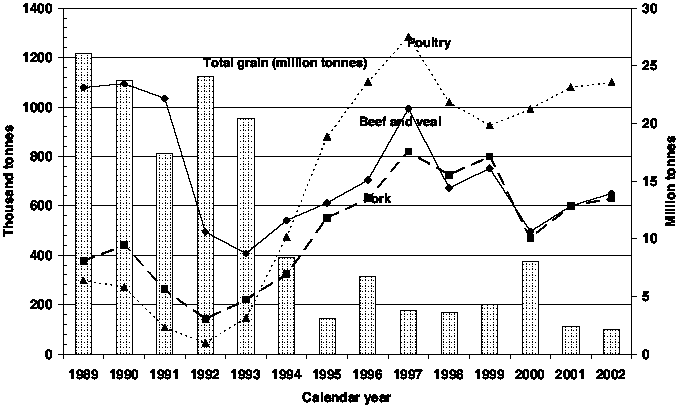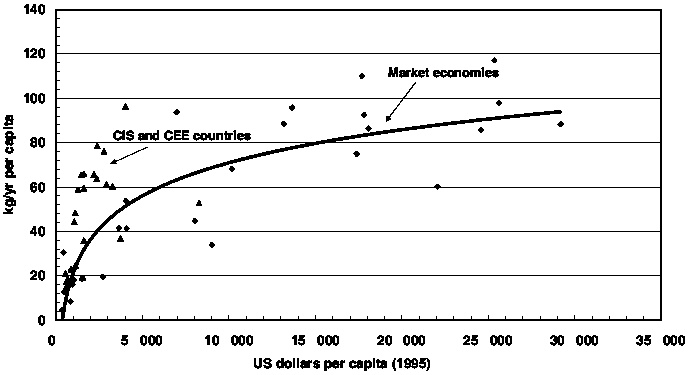By a number of measures food security in the Russian Federation is a matter of great concern at the beginning of the twenty-first century. In 1998 the United States of America and European Union (EU) Governments announced food aid packages valued at over US$1.5 billion for the Russian Federation. The value of United States Government commodity contributions from this total was $409 million, larger than total United States Government food aid to the entire continent of Africa in FY 2000 ($342.4 million).[1] The Government of the Russian Federation is now considering a Doctrine on Food Security, according to which food security is viewed as an important component of national security. And, according to the World Bank, unlike other areas of the world where poverty has decreased in the last decade, poverty in the Russian Federation seems to have increased within the past decade. Since poverty and food insecurity are usually related, it would seem reasonable to suspect that food security has also worsened in the past decade.
With such attention to issues of food security in the Russian Federation, it would seem appropriate to take stock of available information on the topic. How food secure is the Russian Federation? What is the nature of food insecurity in that country? And how can the government ensure a more food secure future? These are the issues that will be addressed in this report.
There are more than 200 definitions and 450 indicators of food security reported in the literature (Hoddinott, 1999). However, there is little disagreement about the core meaning of the concept. The World Food Summit Plan of Action states, “Food security exists when all people, at all times, have physical and economic access to sufficient, safe and nutritious food to meet their dietary needs and food preferences for an active and healthy life.” As such, food security involves three related concepts: food availability, access and proper utilization.
This report addresses both the situation of food security and the outlook for removing constraints on food security in the future. Chapter 1 outlines the changes in agricultural production in the 1990s that have led to a policy debate on food security in the Russian Federation today and reviews Russian views on the topic. Chapters 2, 3 and 4 assess the state of food security in the Russian Federation using the three core concepts: Chapter 2 critically assesses the main indicators of food availability; Chapter 3 discusses the evidence on access to food by the population; and Chapter 4 discusses the nutritional status and diet of the population. Chapter 5 discusses the outlook for improvements in the state of food security.
The debate over “food security” in the Russian Federation over the past ten years has really been a debate over agricultural policy. More specifically, it concerns how to interpret the changes in agricultural production and consumption that have accompanied the introduction of reforms in the economy. There have been two quite important changes in production in the country since policy reforms started in 1992: a sizeable fall in livestock inventories and a corresponding fall in production of feed grain. Accompanying these changes has been a sizeable fall in grain imports and an increase in meat imports. On one side, the agricultural establishment has interpreted these changes as an ongoing “crisis” in the agricultural sector that threatens the food security of the country. Thus, Khromov (1996) stated, “The main threat to the country’s food security comes from the crisis gripping its agriculture and food industry.” Gordeev et al. continued this line of reasoning by stating, “The key problems for raising the level of food security are to end the decline in food production, renew growth, change the geographical and commodity structure of production to correspond to market demand and increase the quality of production of the agro-industry complex” (Gordeev et al., 2001, v. 1, p. 171). On the other side of the debate, a small number of agricultural economists within the country have pointed out that changes in food production have been caused by an adjustment in consumer purchases in line with a switch away from massive consumer subsidies toward actual scarcity prices for livestock products. In this respect, these changes in agricultural production were an inevitable part of a long-term market reform and consistent with an adjustment towards a comparative advantage in the production of crop rather than livestock products.
FIGURE 1
Livestock inventories (1 January)

Source: FAOSTAT.
The dramatic fall in livestock inventories that has occurred since reforms began in 1992 can be seen in Figure 1. Cattle and hog inventories on 1 January 2000 were less than half their level in 1988 and sheep and goat inventories about one-third. The changes in grain production and domestic use that accompanied this change in inventories can be seen in Figure 2. In that figure, the bar shows production, while total domestic use is illustrated by the area graph. Total grain for domestic use is production + net imports + stock changes. Note that although production and total domestic use during the period under consideration both fell by about one half, most of the fall in production was of grain used for feed. Whereas food use of grain fell by about 10 percent, feed use fell by 66 percent.[2]
FIGURE 2
Grain production and use, calendar years 1990-1999

Source: FAOSTAT.
FIGURE 3
Import of grain and meat, 1989-2002

Source: ERS/USDA PS&D Database (2002).
These changes in livestock inventories, grain production and use were accompanied by a significant turnaround in agricultural trade. The USSR was the largest grain importer in the world in the 1980s, importing an average of 36 million tonnes per year, much of which went to Russia (Figure 3). At the end of the 1980s the Russian Federation was importing about 20 million tonnes of grain per year.[3] After 1993, however, the Russian Federation drastically reduced imports of grain. This is entirely reasonable, since feed demand for grain had fallen due to the fall in livestock inventories. Meat imports, particularly of poultry meat, increased rather dramatically in these years (Figure 3). The rouble devaluation of 1998 caused a decrease in meat imports. But healthy economic growth between 1999 and 2001 fuelled a growth in meat imports once again.
The main reasons for these revolutionary changes in Russian agricultural production, use and trade lie in a change in the position of the livestock sector in Russian agriculture in the Soviet period and after. In the 1960s and 1970s, Krushchev and particularly Brezhnev made the decision to improve the Soviet standard of living primarily by increasing consumption of livestock products. To increase meat production, the Brezhnev regime concentrated on investing in “industrial” livestock production (Van Atta, 1993). Demand for meat was ensured by keeping Soviet retail prices for meat virtually constant from the mid-1960s to 1990. Increasing livestock inventories also required increases in grain for feed. Soviet grain production increases (predominantly in Russia and Kazakhstan) of about 60 million tonnes per year from the early 1960s to the late 1970s was not sufficient to support the increase in livestock inventories. For this reason, Soviet imports of grain increased from near zero in 1970 to 36 million tonnes per year in the 1980s (Shend, 1993).
The campaign to raise livestock consumption in the USSR was supported by sizeable subsidies to both consumers and producers for livestock products, particularly for beef and pork. In the USSR consumers were heavily subsidized for livestock products, while producers were subsidized mildly (ERS/USDA, 1994). This meant that the true cost of production of meat in the USSR was considerably higher than the price paid by consumers. Soviet producers received subsidies to offset the shortfall in revenue. Other eastern European countries followed the Soviet lead, subsidizing livestock products, as well. By 1990, Russian food and agricultural subsidies, primarily for livestock products, reached an astounding 11.8 percent of GDP (World Bank, 1997).
The result of state support to livestock producers and consumers was that consumption of livestock products in CEE and CIS countries was higher than consumption of these products in market economies of similar GDP. This “overconsumption of meat” in the CEE and CIS countries in 1992 can be seen by comparing the CEE and CIS countries in Figure 4 with the trend line drawn using market economy points as a reference. The CEE and CIS countries are arrayed above the market economy trend, except for the countries of the former Yugoslavia, Macedonia, Croatia and Slovenia. These eastern European countries were neither in the Soviet bloc nor did they share Soviet-type agricultural policies. Their position in Figure 4 is closer to the trend line derived from market economies. This difference is consistent with the proposition that higher meat consumption was not a matter of regional consumer preference, but of policy differences.
With the beginning of reforms in 1992, demand for livestock products fell rapidly as real wages fell. Moreover, subsidies to producers to support livestock fell abruptly. These demand and supply side pressures caused derived demand for livestock inventories to fall. After 1992 the livestock sector and Russian meat consumption were gradually made more consistent with actual costs of production and consumer income. But the fall in the demand for livestock started a chain reaction that led to a fall in demand for livestock feed, and thus grain production and imports. Feed use of grain fell continuously throughout the 1990s, as livestock inventories were reduced (Sedik, Foster and Liefert, 1996).
These changes in production, use and trade appear to be consistent with Russian comparative advantage in agriculture. Liefert (2002) used Social Cost Benefit (SCB) ratios to calculate whether the country had a comparative advantage in crops or meats, and compared trade flows with the implications of his calculations. The social cost benefit ratio gives the value of all resources used to produce a given good, with tradable inputs valued at trade prices, divided by the total foreign exchange that the good would earn if exported. Thus, the ratio compares the value of resources used to manufacture the good domestically versus the cost to the country of importing it. Comparing SCB between various crops and livestock products, one can conclude which products are more or less competitive on world markets. The country has a comparative advantage in those products for which the SCB are lower.
FIGURE 4
Per capita GNP and meat availability, 1992

Sources: FAOSTAT and World Bank (2002).
In 1996/97 the Russian Federation was more competitive in producing crops, particularly sunflower seed (Table 1), indicated by the comparatively low SCB ratios for this crop. Russian domestic costs of producing poultry and pork were considerably higher than world costs. Thus, movement in the direction of crop production (sunflower seed in particular) seems to have been consistent with the country’s comparative advantage.
TABLE 1
Social cost-benefit ratios and trade
balances, 1996-1997
| |
SCB ratios |
Trade balances |
|
|
(1996-1997) |
1996 |
1997 |
|
|
Meats |
|||
|
Poultry |
13.45 |
-0.74 |
-1.14 |
|
Pork |
8.21 |
-0.30 |
-0.30 |
|
Beef |
6.61 |
-0.45 |
-0.61 |
|
Crops |
|||
|
Wheat |
7.06 |
-1.70 |
-1.60 |
|
Barley |
6.94 |
-0.46 |
-0.76 |
|
Sunflower seed |
4.37 |
1.77 |
1.04 |
Note: Negative value of trade balance indicates net imports.
Source: Liefert (2002), p. 15.
Most of what has been written explicitly on the topic of food security in the Russian Federation concerns interpretations of reform-induced production changes and implications for agricultural policy. This includes a special (1996) issue of the Food Systems Policy Roundtable Journal devoted to issues of food security in contemporary Russia and edited by Richard Nooter. The articles in this journal illustrate both Russian and western views on food security issues. Gordeev et al. (2001) presents a Russian view, linked to national security concerns. Outside the country, there is by now a sizeable literature on poverty in the Russian Federation, but food security is usually not specifically covered under this topic.[4] The role of small-scale agriculture in alleviating poverty has recently come under scrutiny in this literature. In the Soviet period the literature on private plots concerned primarily the role of the private sector in Soviet agricultural production and as a buffer sector for food consumption (OECD, 1991). After 1991 private plots again became a topic of discussion, now as a coping mechanism to ensure food security amongst poor urban and rural households (Seeth et al. (1998), Debatisse and Rajkumar (1997) and Von Braun, Quaim and Seeth (2000)).
In February 2001, FAO and Association Agro (AA) held a workshop, sponsored by the Department for International Development of the United Kingdom (DFID), at which Russian scholars presented papers on the topic of food security in the Russian Federation. The workshop was the first time that food security issues as they are usually understood in other countries had been discussed in relation to the Russian Federation in a public forum. At the workshop Serova discussed the implications of reforms and agricultural policies for food security in the sense of hunger resulting from poverty (Serova et al., 2001). In this context private plots as a “buffer mechanism” against poverty were discussed. Ovcharova (2001) discussed measures of poverty in the Russian Federation and noted the limited effectiveness of the social welfare system in providing a safety net, even for adequate food consumption. Korbut and Shashnov (2001) discussed measures of poverty and their applicability as measures of food security. Baturin (2001) discussed recent literature on the main nutrition problems in the Russian Federation.
The Russian literature on nutrition has traditionally emphasized case studies with few references to nutrition policy. However, nutrition has come under great scrutiny in studies outside the region in the past ten years in connection with the drastic fall in life expectancy and deterioration of health conditions in the Russian Federation. Martinchik, Baturin and Helsing (1997) reported on the results of a WHO monitoring effort of Moscow schoolchildren from 1992 to 1995. They found that, although Russians felt that they had been food deprived during the period, there is no evidence that growth of children in the study had been compromised. Popkin et al. (1997a) reviewed the history of the nutritional changes from the 1960s to 1990s in Russia and, relying on data from the Russian Longitudinal Monitoring Survey (RLMS) of 1992 and 1993, noted the main health problems which arose during the period. Their findings, similar to those in Sedik (1993) and Van Atta (1993), are that the Russian diet changed dramatically from the 1960s to the early 1990s from one dominated by bread and potatoes to one with high meat and dairy content. These diet changes led to a rise in health problems of the population related to heart and circulatory diseases, maladies normally associated with richer countries.
There have also been a number of studies that have drawn on data collected under the Russian Longitudinal Monitoring Survey (RLMS) (Popkin, Zohoori and Baturin, 1996; Popkin et al., 1997b; Mroz, Henderson and Popkin, 2001; Zohoori, Gleiter and Popkin, 2001). These sources have made available a wealth of information on Russian health and nutrition that was not previously available. Finally, there has been some interest in public health policy and nutrition, particularly from the World Health Organization. The WHO Regional Office for Europe has put out a number of works dealing with nutrition policy for the European region (WHO, 1998a, 2000a, 2001).
|
[1] The United States package
involved 3.2 tonnes of commodities, and included donations worth about US$589
million (US$409 million for 1.9 tonnes of commodities and US$180 million for
transportation), plus a US$520 million trade credit for the Russian Federation
to purchase 1.3 tonnes of commodities such as maize, soybeans and meat under
P.L.-480 Title I. The donated commodities included 1.7 tonnes of wheat from the
Commodity Credit Corporation and 0.2 tonnes of various commodities from the
United States Food for Progress Program. The EU package provided 1.8 tonnes of
agricultural products (including 1 tonne of wheat) worth US$470 million (Liefert
and Liefert [1999], p. 17). [2] The actual changes in food use of grain are difficult to determine, because a significant portion of bread was given to animals as feed during the Soviet period. After 1992, when bread gradually became more expensive, it is likely that feed use of bread declined (OECD, 1991, p. 168). [3] Grain import data in Figure 3 is in marketing years, while livestock data is for calendar year. The series are aligned such that calendar year 1989 meat import data is compared with grain data utilized in that calendar year (1988). This is MY July/June 1988/89 grain import data. [4] On poverty in the Russian Federation and other transition economies, see Klugman (1997), Milanovic (1998), Braithwaite, Grootaert and Milanovic (1999), World Bank (2000) and OECD (2001). |